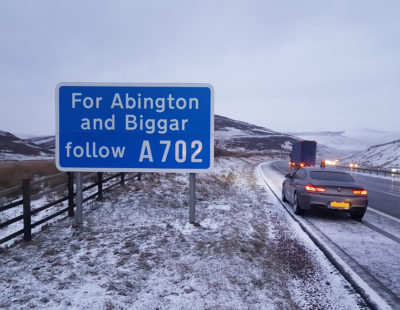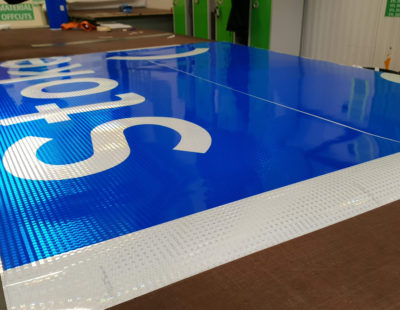If traffic signs are not clearly visible, they can be detrimental to road safety. An illegible traffic sign can distract road users and/or hinder drivers’ uptake of vital information. Therefore, the inspection and maintenance of permanent traffic signs is not only important, but crucial to safety.
In this article, our team at Lakeside Group explain all you need to know about ‘National Highways CS 125 inspection of traffic signs’, the standard which sets out the requirements for the inspection of permanent traffic signs.
View the full CS 125 Inspection of Traffic Signs document >
Why do road traffic signs need to be tested (according to National Highways CS 125)?
It is extremely important that all traffic signs are inspected every two years (CS 125 requirement 2.3.3) to ensure they remain free from defects or failures which may prevent “minimum clear visibility”.
Legible signs help to save lives by avoiding confusion on the roads. Driving at night on dark roads requires clear retroreflection as the road signs provide valuable information to drivers and other road users. They represent rules that are in place to keep you safe, as well as helping others to communicate messages to drivers and pedestrians that can maintain, order and reduce accidents.
Key requirements of National Highways CS 125
Below are some of the key requirements of CS 125, which play a vital role in ensuring traffic signs are well maintained and therefore, safe for road users. These requirements clearly outline how traffic signs should be inspected, the frequency of this, and what should be assessed at each inspection.
CS 125 Requirement 2.2
Inspections of each traffic sign shall be undertaken periodically under both daytime and night-time conditions.
CS 125 requirement 2.1
The following elements shall be assessed as part of the inspection: visual performance; structural integrity; electrical safety; the need for removal or replacement.
CS 125 requirement 2.3.2
The inspection regime may comprise a combination of on-site inspections, routine patrols, and mobile inspections using automated asset data collection technologies.
CS 125 requirement 2.3.3
The duration between inspections of each traffic sign should be no greater than two years.
CS 125 requirement 2.5
Inspection of each traffic sign shall determine whether there are any defects or failures which are preventing minimum clear visibility.
CS 125 requirement 2.6.8
Where degradation in the retroreflective performance of a traffic sign or a part of a traffic sign is suspected, the extent of the problem and the need for intervention should be ascertained by measuring the coefficient of retroreflection.
In addition to the above visual inspection requirements, National Highways CS 125 also requires that the coefficient of retroreflectivity of traffic signs (CS 125 Appendix A) should be measured at certain intervals depending on material type, which will be discussed in further detail below.
View the full breakdown of National Highways CS 125 >
National Highways CS 125 Measuring the Coefficient of Retroreflection (Appendix A)
National Highways CS 125 Appendix A stipulates that, in addition to visual inspections every two years, traffic signs should have the coefficient of retroreflectivity measured at certain intervals too – depending on material type as explained below. Similar to visual inspections, checking retroreflectivity has huge impacts on traffic sign discernability, and therefore, safety. These inspections are also clearly specified within CS 125 to ensure consistent, effective inspections.
National Highways CS 125 Appendix A specifies:
- – The measurement of the coefficient of retroreflection should be carried out using a calibrated, handheld retroreflectometer with the settings adjusted to an observation angle of 20′ and an entrance angle of +5°.
- – Reference should be made to BS EN 12899-1 [Ref 2.N] for supplementary details of the procedure to be followed in measuring the coefficient of retroreflection, including definitions of the observation angle and the entrance angle.
- – Before the measurement is carried out, the traffic sign face should be cleaned and the performance class of the retroreflective sheeting material under assessment should be identified.
- – The retroreflectometer should be positioned against the traffic sign face and operated in accordance with the manufacturer’s instructions.
- – In addition to a visual inspection every 2 years, the coefficient of retroreflectivity of traffic signs should be measured at certain intervals depending on material type:
-
- – Performance Class RA1 materials should be measured every 7 years.*
- – Performance Class RA2, R2, R3B-UK and R3C-UK materials should be measured every 10 years.*
-
* Earlier measurements of the coefficient of retroreflection may be necessary, please refer to National Highways CS 125 Appendix A for more information.
As specialist suppliers of high-quality reflective products, we stock a wide range of certified reflective materials for traffic signs. If you’re looking for a material which offers the greatest light return of all the UK material classes (Class R3C) with an industry-leading 15 year warranty, why not find out more about Avery Dennison T-11500 OmniCube R3C. Combine this with one of our range of protective overlaminates, such as Avery Dennison OL-1200 dew resistant overlay film, to ensure exceptional performance throughout the life of the sign.
View the T-11500 OmniCube R3C datasheet >
Find out more about dew-resistant overlay films >
What is a retroreflectometer?
As specified in CS 125 above, measuring the coefficient of retroreflection of traffic signs must be conducted using a calibrated retroreflectometer. These handheld devices are purpose-built to measure all types of retroreflection, including sheeting on traffic signs. The operator places the device against the reflective material and presses the trigger to emit a light pulse at specific angles, the device then measures how much of that light returns and provides the operator with that data.
Boasting a range of features and settings, here at Lakeside Group we offer the RetroSign GRX, the perfect retroreflectometer to conduct CS 125 Appendix A compliant traffic sign inspections.
Find out more about the RetroSign GRX >
Achieve National Highways CS 125 compliance with Lakeside Group
For expert advice on ensuring compliance with CS 125, or to find out more about purchasing or hiring a RetroSign GRX retroreflectometer, get in touch with our team today. Our expert knowledge paired with our industry leading product range ensures we offer solutions guaranteed for the long haul.




